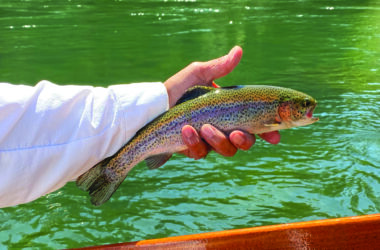As I prepare this week’s Angler’s Log, the McKenzie River at the Vida gage site has fallen to about 2 feet, an ideal range for fishing and boating, and will continue to recede as we inch closer toward summer. You can also easily correlate the current conditions on the McKenzie to just about every other river, stream or creek in our region, all of which are also now in wonderful condition.
I’ll also add that dozens of the southern Willamette Valley’s cold-water resources have recently been stocked – in some cases with thousands of rainbow trout raised in both state and contracted private hatcheries. The fish are generally released at a rate of two or three trout per pound although “oversized” trout are often added to the mix. At about two pounds each, on the hook the fish is energetic and puts up a good fight. They’re also large enough to fillet for your grill or baked with butter, onions and lemon in a loose foil wrap.

Receding river levels have also reignited the Willamette River’s spring chinook run. You might recall that high and cold water from spring runoff in May had slowed the run for several days. But those conditions have waned and at press time, spring chinook salmon have been streaming into the Willamette Valley headed to the Santiam, McKenzie, Coast Fork of the Willamette and the Middle Fork of the Willamette.
So far, about 11,000 springers have passed over the Willamette Falls, at a rate of 500 to 600 per day, with the largest portion of “springers” heading to the base of Dexter Dam on the Willamette River’s Middle Fork.
No doubt there are also salmon that have now reached the base of Leaburg Dam and at Foster Dam on the South Sanitam River too. I can also report to you that the first salmon of the spring chinook salmon run has already been caught on the Middle Fork of the Willamette. That honor goes to local fishermen Don Michael Cambra of Eugene, “DM” hooked a full-bodied wild chinook that was gently held for a photo as proof of catch and quickly released.
Willamette spring chinook are famous for the quality of their bite and fresh salmon eggs – or live sand shrimp, rigged individually or as a cocktail – is the most popular bait among our top local guides for a reason. “Back bouncing” a fresh bait into the deeper holes and runs is a technique that goes back a century. But it still accounts for the largest number of salmon caught in our local waters. The peak of the spring salmon run is still another four weeks away and given the size of the predicted run, good salmon fishing in all our local salmon rivers should last well into and likely beyond the end of July this season. I’ll have much more about salmon fishing in the next Angler’s Log, including how to select a rod and reel combination and how to rig your rod to fish for salmon specifically from the river bank.
In the eastern segments of the Willamette Valley, nearly every river and lake are open to year-round fishing. Many of those locations roughly lay east of the north-and-south-running Highway 99. The ODFW starts planting hatchery trout in late January into several low-level west slope Cascade reservoirs, a few ponds on the valley floor and a couple of natural lakes near Florence. Also, west of Highway 99 and more specifically the rivers and streams that drain the west-facing slopes of the coastal mountains. More popular for their fall and winter runs of salmon and steelhead get no hatchery trout at all. But hold a solid population of natural spawning wild cutthroat trout. That season opened on May 23 and runs to the end of October. In our backyard is the Siuslaw River, the forks of which reach all the way into the Lorane Valley, and with about a dozen tributaries there is in fact a lifetime of angling exploration and discovery within that single drainage. You are allowed to harvest two wild cutthroats per day over 8 inches and have 6 fish in your possession. Above tide water, no bait is allowed for and you are restricted to the use of flies, and lures.
Lastly, a reminder that June 3 and 4 are free fishing days in Oregon. No license is required to fish for any species of game or shellfish fish, but you are required to honor the regulations. You’ll find more about “Free Fishing Weekend” at www.myodfw.com.
Email: [email protected]








